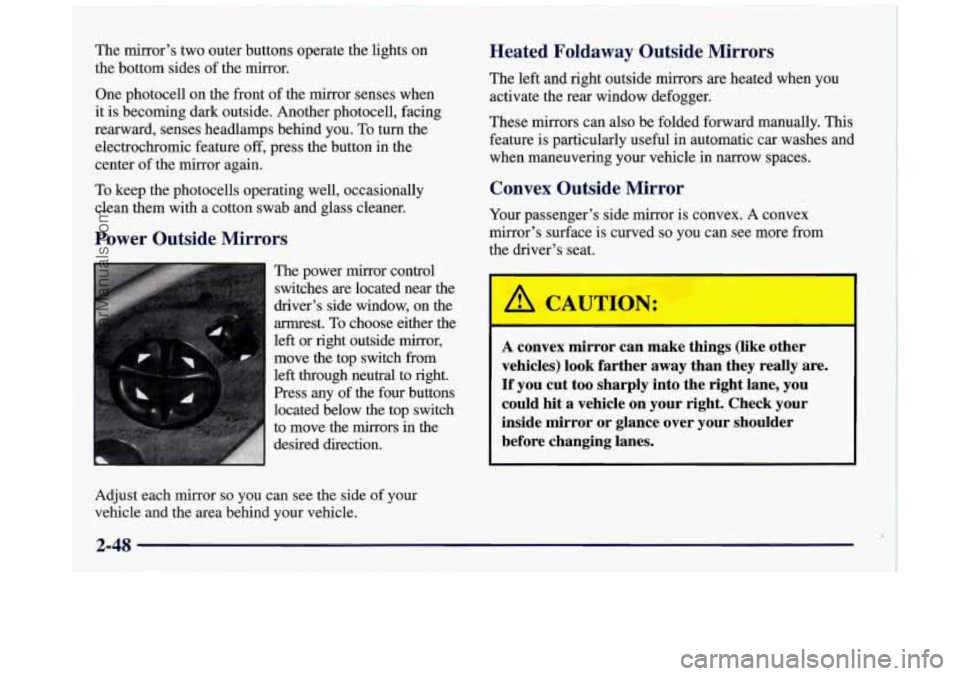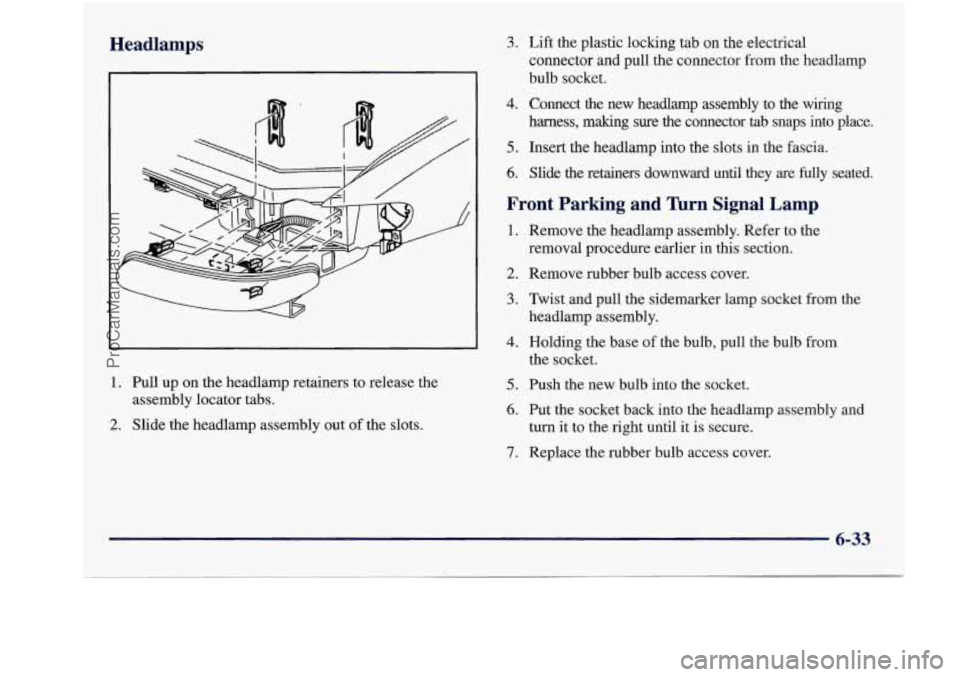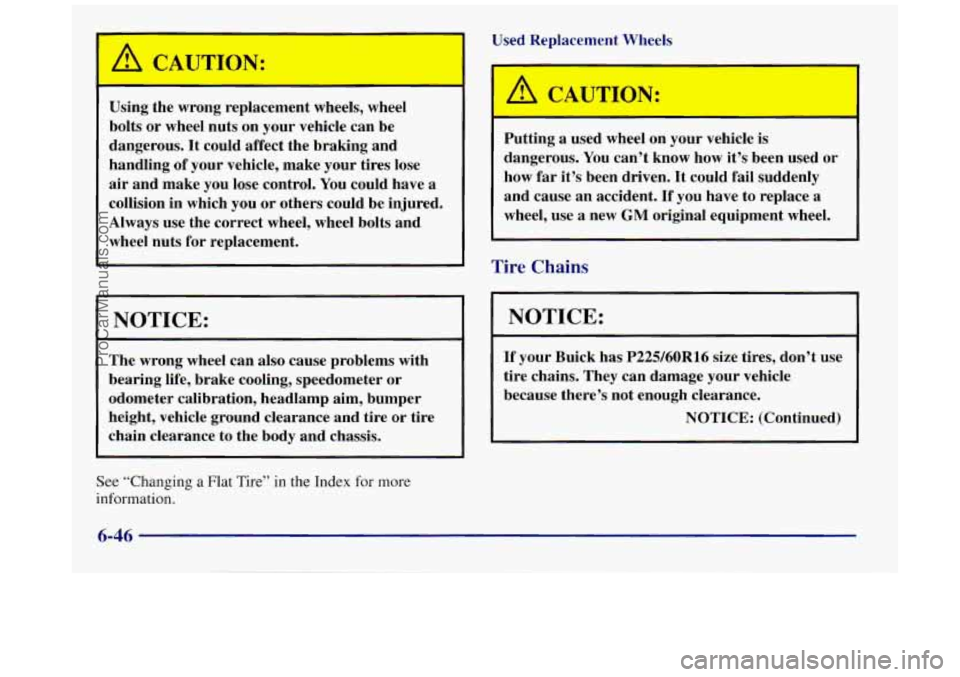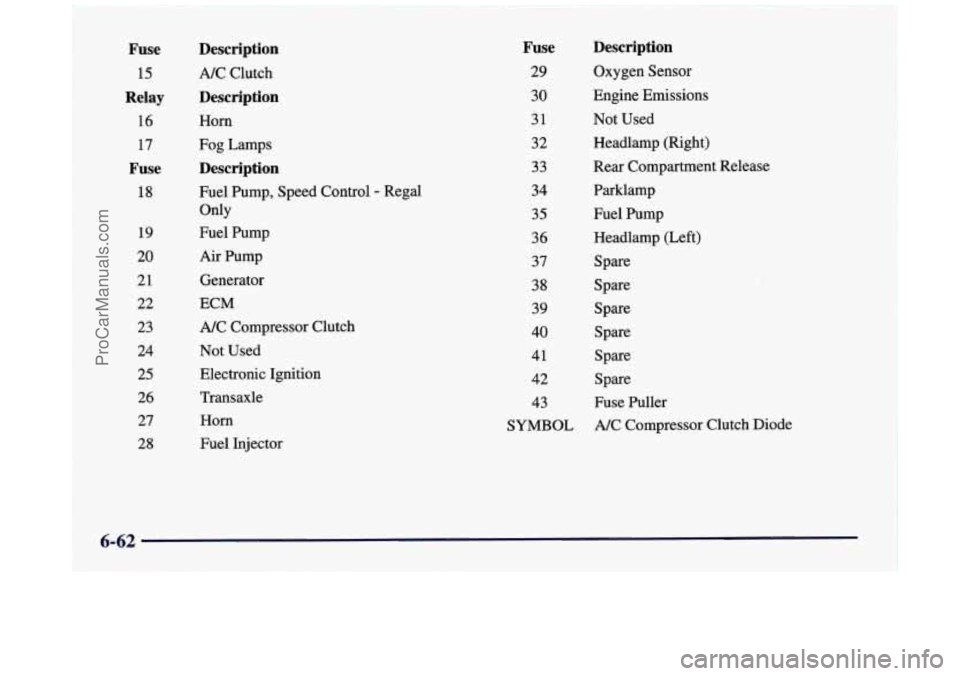1997 BUICK REGAL headlamp
[x] Cancel search: headlampPage 123 of 422

Mirrors
Adjust all the mirrors so you can see clearly when YOU
are sitting in a comfortable driving position.
Inside Daymight Rearview Mirror Electrochromic
Daymight Rearview Mirror
(If Equipped)
To reduce glare from lamps behind you, pull the lever
toward
you (to the night position). To return the mirror
back to the day position, push the lever away from
you.
Your Buick may have an electrochromic dayhight
rearview mirror.
Push the button in the center of the
mirror to turn
this feature on. The mirror will darken
gradually
to reduce glare from headlamps behind you.
This may take
a few moments.
2-47
ProCarManuals.com
Page 124 of 422

~ The mirror’s two outer buttons operate the lights on
~ the bottom sides of the mirror.
~ One photocell on the front of the mirror senses when
it is becoming dark outside. Another photocell, facing
rearward, senses headlamps behind you. To turn the electrochromic feature
off, press the button in the
center of the mirror again.
To keep the photocells operating well, occasionally
clean them with a cotton swab and glass cleaner.
Power Outside Mirrors
The power mirror control
switches are located near the
driver’s side window, on the
armrest.
To choose either the
left or right outside
mirror,
move the top switch from
left through neutral to right.
Press any of the four buttons
located below the top switch
to move the mirrors
in the
desired direction.
Heated Foldaway Outside Mirrors
The left and right outside mirrors are heated when you
activate the rear window defogger.
These mirrors can also be folded forward manually. This
feature
is particularly useful in automatic car washes and
when maneuvering your vehicle in narrow spaces.
Co-- -- - -: Outside Mirror
Your passenger’s side mirror is convex. A convex
mirror’s surface is curved
so you can see more from
the driver’s seat.
J I1U.
A convex mirror can make things (like other
vehicles) look farther away than they really are.
If you cut too sharply into the right lane, you
could hit
a vehicle on your right. Check your
inside mirror or glance over your shoulder
before changing lanes.
Adjust each mirror so you can see the side of your
vehicle and the area behind your vehicle.
2-48
ProCarManuals.com
Page 214 of 422

Here are some tips on night driving.
Drive defensively.
Don’t drink and drive.
Adjust your inside rearview mirror to reduce the
glare from headlamps behind you.
Since you can’t see as well, you may need to
slow down and keep more space between you and
other vehicles.
Slow down, especially on higher speed roads. Your
headlamps can light up only
so much road ahead.
In remote areas, watch for animals.
If you’re tired, pull off the road in a safe place
and rest.
Night Vision
No one can see as well at night as in the daytime. But as
we get older these differences increase. A 50-year-old
driver may require at least twice as much light to see the
same thing at night as a 20-year-old.
What you do in the daytime can also affect your night
vision. For example, if you spend the day
in bright
sunshine you are wise to wear sunglasses. Your eyes will
have less trouble adjusting to night. But
if you’re
driving, don’t wear sunglasses at night. They may cut down
on glare from headlamps, but they also make
a lot
of things invisible.
You can be temporarily blinded by approaching
headlamps. It can take a second or two, or even several
seconds, for your eyes to readjust to the dark. When you
are faced with severe glare (as from a driver who
doesn’t lower the high beams, or a vehicle with
misaimed headlamps), slow down a little. Avoid staring
directly into the approaching headlamps.
Keep your windshield and all
the glass on your vehicle
clean
-- inside and out. Glare at night is made much
worse by dirt on the glass. Even
the inside of the glass
can build
up a film caused by dust. Dirty glass makes
lights dazzle and flask, more than clean glass would,
making the pupils of your eyes contract repeatedly.
Remember that your headlamps light
up far less of a
roadway when you are
in a turn or curve. Keep your
eyes moving; that way, it’s easier to pick out dimly
lighted objects. Just as your headlamps should be
checked regularly for proper aim,
so should your eyes
be examined regularly. Some drivers suffer from night
blindness
-- the inability to see in dim light -- and
aren’t even aware of it.
ProCarManuals.com
Page 227 of 422

Run your engine only as long as you must. This saves
fuel. When you run the engine, make it go a little faster
than just idle. That is, push the accelerator slightly. This
uses less fuel for the heat that you get and it keeps the
battery charged. You will need a well-charged battery to
restart the vehicle, and possibly for signaling later on
with your headlamps. Let the heater run for a while.
Then, shut the engine off and close the window almost
all the way to preserve the heat. Start the engine again
and repeat this only when
you feel really uncomfortable
from the cold. But do
it as little as possible. Preserve the
fuel as long as you can.
To help keep warm, you can get
out of the vehicle and do some fairly vigorous exercises
every half hour or
so until help comes.
Loading Your Vehicle
OCCUPANTS VEHICLE CAP. WT.
TIRE-LOADING INFORMATION
FRT. CTR. RR. TOTAL LBS. KG
MAX. LOADING & GVWR SAME AS VEHICLE
CAPACITY WEIGHT XXX COLD TIRE
TIRE SIZE SPEED PRESSURE
RTG PSIlKPa
FRT.
RR.
SPA.
IF TIRES ARE HOT,
ADD 4PSIi28KPa
SEE OWNER’S MANUAL
FOR ADDITIONAL
, INFORMATION
Two labels on your vehicle show how much weight it
may properly carry. The Tire-Loading Information label
is inside the trunk lid. The label tells you the proper size,
speed rating and recommended inflation pressures for
the tires on your vehicle. It also gives you important
information about the number
of people that can be in
your vehicle and the total weight you can carry. This
weight is called the vehicle capacity weight and includes
the weight of all occupants, cargo and all
nonfactory-installed options.
4-31
ProCarManuals.com
Page 309 of 422

Headlamps
1. Pull up on the headlamp retainers to release the
2. Slide the headlamp assembly out of the slots.
assembly locator tabs.
3. Lift the plastic locking tab on the
electrical
connector and pull the connector from the headlamp
bulb socket.
4. Connect the new headlamp assembly to the wiring
5. Insert the headlamp into the slots in the fascia.
6. Slide the retainers downward until they are fully seated.
Front Parking and Tbrn Signal Lamp
1. Remove the headlamp assembly. Refer to the
removal procedure earlier in this section.
2. Remove rubber bulb access cover.
3. Twist and pull the sidemarker lamp socket from the
4. Holding the base of the bulb, pull the bulb from
5. Push the new bulb into the socket.
6. Put the socket back into the headlamp assembly and
turn it to the right until it is secure.
7. Replace the rubber bulb access cover.
harness, making sure
the connector tab snaps into place.
headlamp assembly.
the socket.
6-33
ProCarManuals.com
Page 322 of 422

1 Used Replacement Wheels
Using the wrong replacement wheels, wheel
bolts or wheel nuts on your vehicle can be
dangerous. It could affect the braking and
handling
of your vehicle, make your tires lose
air and make you lose control. You could have
a
collision in which you or others could be injured.
Always use the correct wheel, wheel bolts and
wheel nuts for replacement.
NOTICE:
The wrong wheel can also cause problems with
bearing life, brake cooling, speedometer or
odometer calibration, headlamp aim, bumper height, vehicle ground clearance and tire or tire
chain clearance
to the body and chassis.
See “Changing a Flat Tire”
in the Index for more
information. Putting
a used wheel
on your vehicle is
dangerous. You can’t know how it’s been used or
how far it’s been driven. It could fail suddenly
and cause an accident.
If you have to replace a
wheel, use a new
GM original equipment wheel.
Tire Chains
NOTICE:
If your Buick has P225/60R16 size tires, don’t use
tire chains. They can damage your vehicle
because there’s not enough clearance.
NOTICE: (Continued)
6-46
ProCarManuals.com
Page 334 of 422

Electrical System
Add-on Electrical Equipment
I NOTICE:
Don’t add anything electrical to your Buick
unless you check with your dealer first. Some
electrical equipment can damage your vehicle and the damage wouldn’t be covered by your
warranty. Some add-on electrical equipment
can keep other components from working as
they should.
Your vehicle has an air bag system. Before attempting to
add anything electrical to your Buick, see “Servicing
Your Air Bag-Equipped Buick” in the Index.
Headlamp Wiring
The headlamp wiring is protected by a circuit breaker in
the underhood electrical center. An electrical overload
will cause the lamps to
go on and off, or in some cases
to remain off. If this happens, have your headlamp
system checked right away.
Windshield Wipers
The windshield wiper motor is protected by a circuit
breaker and a fuse. If the motor overheats due to heavy
snow, etc., the wiper will stop until the motor cools. If
the overload is caused by some electrical problem, have
it fixed.
Power Windows and Other Power Options
Circuit breakers in the fuse panel protect the power
windows and other power accessories. When the current
load is too heavy, the circuit breaker opens and closes,
protecting the circuit until the problem is fixed.
6-58
ProCarManuals.com
Page 338 of 422

Fuse
15
Relay
16 17
Fuse
18
19
20
21
22 23
24
25
26
27
28
Description
A/C Clutch
Description
Horn
Fog Lamps
Description
Fuel Pump, Speed Control - Regal
Only
Fuel Pump
Air Pump
Generator
ECM
A/C Compressor Clutch
Not Used
Electronic Ignition
Transaxle
Horn
Fuel Injector
Fuse
29
30
31
32 33
34
35
36
37
38
39
40 41
42
43
SYMBOL
Description
Oxygen Sensor
Engine Emissions
Not Used
Headlamp (Right)
Rear Compartment Release
Parklamp
Fuel Pump
Headlamp (Left)
Spare
Spare Spare
Spare
Spare
Spare
Fuse Puller
A/C Compressor Clutch Diode
ProCarManuals.com